Lynx 4VE360BD, 4VW360BD Manual
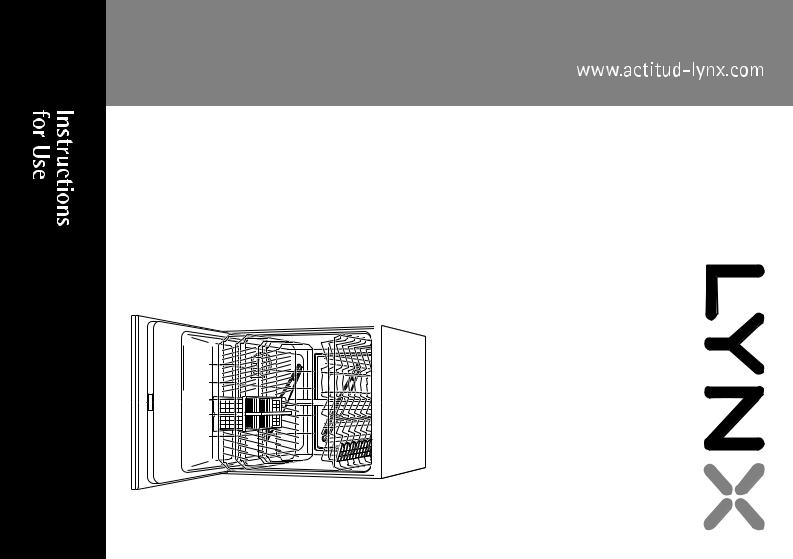
9000 140 819 (8511)
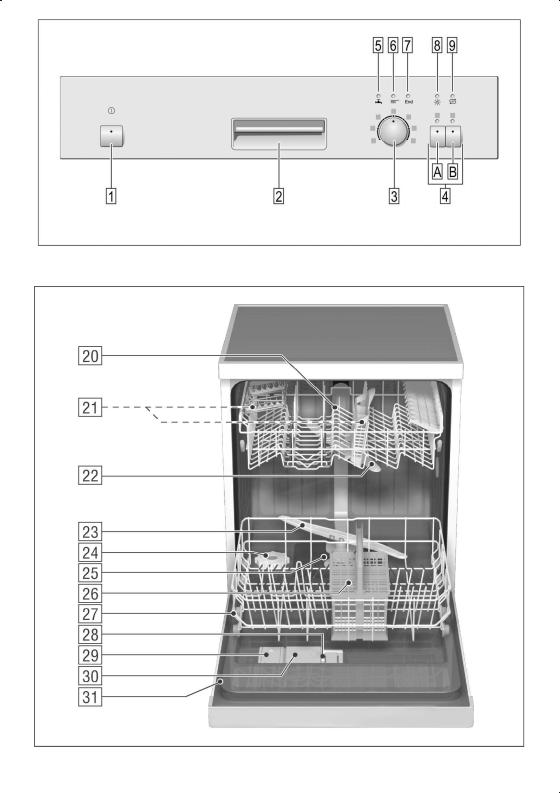

en |
Index |
|
|
|
Safety instructions . . . . . . . . . . . . . |
4 |
Programme overview . . . . . . . . . . |
16 |
|
Getting to know your appliance . . |
6 |
Washing dishes . . . . . . . . . . . . . . . |
17 |
|
Water softener . . . . . . . . . . . . . . . . |
7 |
Additional functions . . . . . . . . . . . . |
18 |
|
Filling in the Salt . . . . . . . . . . . . . . . |
8 |
Maintenance and care . . . . . . . . . . |
19 |
|
Adding rinse aid . . . . . . . . . . . . . . . |
9 |
Fault finding . . . . . . . . . . . . . . . . . . |
21 |
|
Not suitable for the dishwasher . . |
10 |
Customer Service . . . . . . . . . . . . . |
24 |
|
Arranging crockery, glasses, |
|
Information . . . . . . . . . . . . . . . . . . . |
24 |
|
etc. in the dishwasher . . . . . . . . . . |
11 |
Installation . . . . . . . . . . . . . . . . . . . . |
25 |
|
Detergents . . . . . . . . . . . . . . . . . . . |
14 |
Waste disposal . . . . . . . . . . . . . . . . |
26 |
|

en
Safety instructions
Delivery
Immediately check the packaging and dishwasher for any damage which may have been caused in transit. Do not use a damaged appliance, but consult your supplier.
Please dispose of packaging material properly:
The corrugated cardboard consists mainly of waste paper.
The polystyrene moulded parts have been foamed without any CFCs.
The polyethylene film (PE) consists partly of secondary raw material.
The wooden frames (if fitted) are made of residual wood and are untreated.
The hoops (if fitted) consist of polypropylene (PP).
Installation
Install and connect the appliance according to the installation and assembly instructions.
The dishwasher must NOT be connected to the power supply during installation.
Ensure that the protective conductor system of the domestic electricity supply has been installed correctly. Electrical connection conditions must correspond with the specifications on the rating plate of the dishwasher.
If the dishwasher is to be installed
in a high-sided unit, ensure that the unit is attached properly and also at the rear.
Built-under and built-in appliances should always be installed under a continuous work surface which is attached to the adjacent cupboards, in order to ensure that the appliance is entirely stable.
After the appliance has been installed, the mains plug should still be easily accessible.
Not on all models:
The plastic housing on the water input contains an electrically operated valve. The connecting wires are inside the inlet hose. Do not cut through this hose and do not immerse the plastic housing in water.
Warning
For safety reasons, if the appliance is not fitted in a recess, thereby making a side wall accessible, the door hinge area should be covered at the side.
(Risk of injury)
Covers are available as optional accessories from customer services or specialist stores.
4

In daily use
Warning
Knives and other utensils with sharp points must be placed in the baskets either flat or with the points downwards.
Use the dishwasher only in the household and only for its designed purpose, i.e. for washing domestic dishes.
Do not lean or sit on the open door. The appliance could tip.
Please note that free-standing appliances may tip over if the baskets are overloaded.
The water in the appliance is not drinking water.
Do not add any solvents to the washing chamber. Danger of explosion!
Open the door carefully when the programme is still running. Water could spray out of the appliance.
To prevent injuries, e.g. caused by stumbling, open the dishwasher only briefly in order to load and unload the dishwasher.
Read and observe the safety information and instructions for use on the packaging for cleaning and rinsing agents.
Children in the household
Do not let infants play or operate the dishwasher.
Keep cleaning and rinsing agents out of the reach of infants. These may cause chemical burns in the mouth, throat and eyes or asphyxiation.
Keep infants away from the open dishwasher. It could contain residue of the cleaning agent.
If the appliance is installed at eye-level, ensure when opening and closing the door that children are not caught or crushed between the appliance door and the cupboard door situated below.
en
Child-proof lock*
* some models
Comply with the drawings in the back of the envelope.
40Switch on the child-proof lock
41Open the door with child-proof lock switched on
42Switch off the child-proof lock
When the door is open, the child-proof lock offers no protection.
If a fault occurs
Repairs or other work on the dishwasher should only be carried out by a qualified specialist.
The dishwasher must be disconnected from the electricity supply before any repairs or other work are started. Pull the mains plug out of the wall socket or switch off at the fuse box. Grasp the plug to remove it from the socket; do not tug on the cable. Turn the water off at the tap.
When disposing of old appliances
Appliances that have reached the end of their service life should be rendered inoperable in order to exclude the possibility of subsequent accidents. Pull the mains plug out of the wall socket, cut through the connecting cable and disable the door lock.
Take the appliance to a designated waste disposal centre.
Warning
Children could get locked in the appliance (risk of suffocation) or get stuck in other positions.
Therefore: Remove the mains plug, cut the mains wire and set aside. Damage the door lock so that the door can no longer be closed.
5

en
Getting to know your appliance
Diagrams of the control panel and the interior of the appliance can be found in the envelope at the front.
Individual positions are referred to in the text.
Control panel
1Main switch
2Door Opener
3Programme selector (retractable*)
4Additional options*
5ªCheck water supplyº display
6Programme sequence display
7ªEnd of programmeº display
8Rinse-aid refill indicator
9Salt refill indicator
*some models
Appliance interior
20Upper basket with additional cup rack
21Additional cutlery basket for the top basket*
22Top spray arm
23Bottom spray arm
24Dispenser for salt
25Filters
26Cutlery basket
27Bottom basket
28Lock for detergent dispenser
29Dispenser for rinse aid
30Detergent dispenser
31Rating plate
*some models
You will need to purchase the following before using the dishwasher for the first time:
±special salt for use in dishwashers
±detergent
±rinse-aid
Only use products, which are suitable for dishwashers.
6
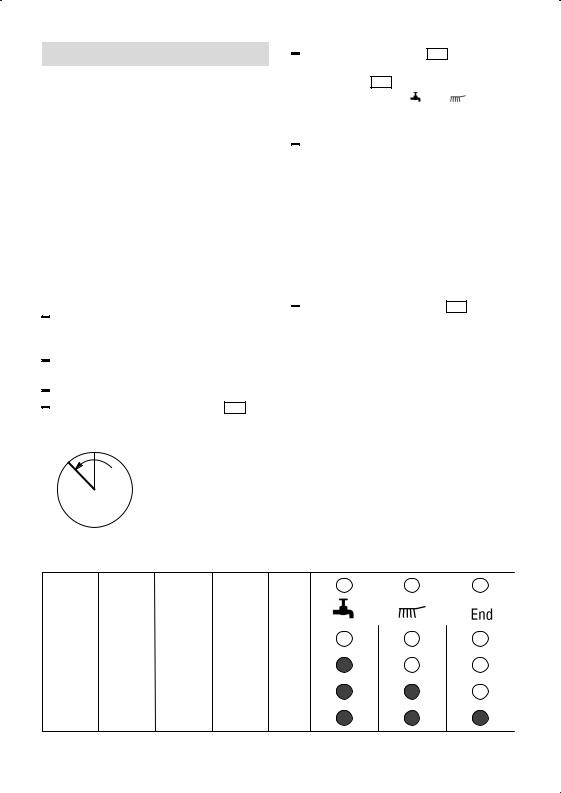
Water softener
In order to rinse dishes and glasses satisfactorily, the dishwasher requires soft water, i.e. containing little or no lime, otherwise water stains will be left behind on crockery and glasses, etc.
If the tap water exceeds a certain level of hardness, it must be softened, i.e. decalcified, so that it can be used in the dishwasher.
This is achieved by adding a special salt to the water softener inside the dishwasher.
The water softener, that is the required amount of salt, is set up according to how hard the tap water is.
Setting up the water softener
Determine the level of hardness of your tap water. Your local water company or service agent can help you with this.
Identify setting from the following water hardness table.
Close the door
Rotate the programme selector 3 from the 12 o'clock position by one notch to the left.
en
Switch on main switch 1 and hold
down for at least 3 sec.
The display 9 flashes and the lamps
|
above the symbols |
and light up. |
|
|
(hardness value has been set to 2 |
||
|
at the factory). |
|
|
|
To change the setting: Rotate the |
||
|
|||
|
programme selector |
|
. |
|
3 |
||
You can select a set value between 0 and 3 according to the hardness of your water.
If the lamps  ,
,  and
and  light up, the maximum set hardness value
light up, the maximum set hardness value
has been reached. If the set hardness value is now increased again, the lamps go out and the set hardness value is set to 0 (no lamp lights up). Switch off the main switch 1 .
The chosen setting has now been stored.
|
|
|
|
|
|
|
Water hardness table |
|
|
|
|||
_dh |
|
_fH |
_Clarke mmol/l |
|
|
|
|
|
|
||||
|
|
|
|
|
|
|
0±6 |
0±11 |
0±8 |
0±1,1 |
0 |
|
|
|
|
|
|
|
|
|
7±16 |
12±29 |
9±20 |
1,2±2,9 |
1 |
|
|
|
|
|
|
|
|
|
17±21 |
30±37 |
21±26 |
3,0±3,7 |
2 |
|
|
|
|
|
|
|
|
|
22±35 |
38±62 |
27±44 |
3,8±6,2 |
3 |
|
|
|
|
|
|
|
|
|
7
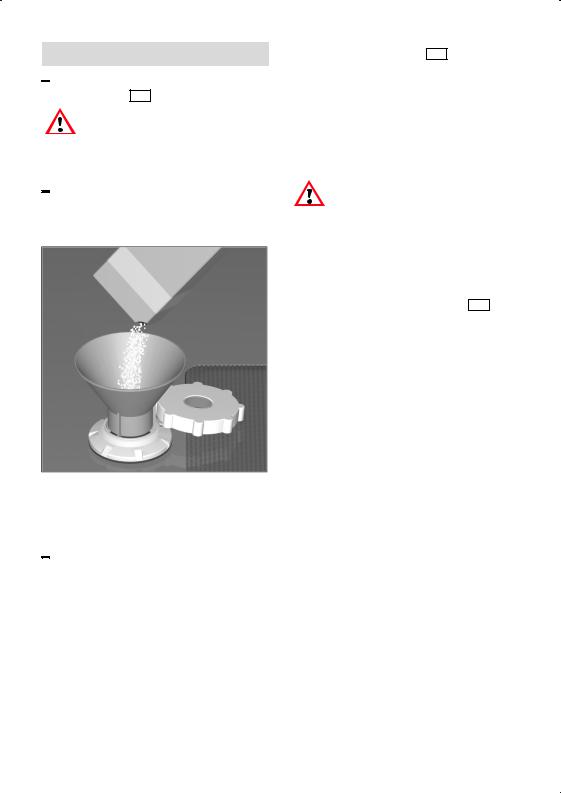
en
Filling in the Salt
Open the screw-type cap of the compartment 24 .
Warning
Before switching on the appliance for the first time, pour approx. 1 litre of water into the salt dispenser.
Then refill with salt (not cooking salt) until the salt container is full
(max. 1.5 kg). When you refill the salt, water is being displaced and drains off.
Refill with salt always just before switching on the appliance in order to prevent corrosion. As a result, any salt solution which has run over will be immediately diluted and flushed out.
Then clean the filling area of salt residues and screw the compartment lid back on without tilting the lid.
The LOW SALT indicator 9 on the front panel will light up initially but will extinguish again after a short period when the salt solution has become sufficiently concentrated.
If the set hardness value is º0º, do not add salt because no salt is used during operation; the salt refill indicator
is switched off.
Do not pour detergent into the container for special salt. This would destroy the water softener.
Salt refill indicator
As soon as the salt refill indicator 9 is lit on the control panel, refill with salt immediately before the next rinse cycle.
Depending on the washing frequency and the hardness setting, the regeneration salt may not have to be topped up for several months.
8
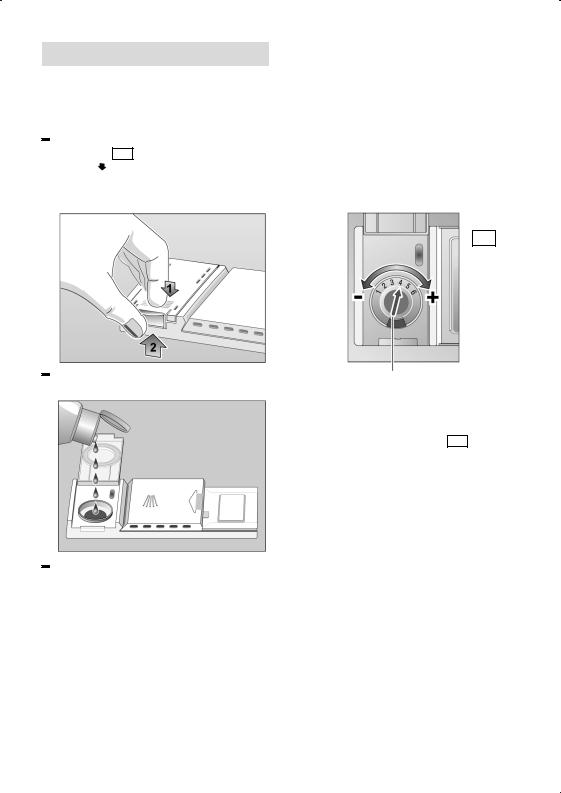
Adding rinse aid
The rinse aid is required for stain-free utensils and clear glasses.
Use only rinse aid for domestic dishwashers.
Open the cover on the rinse-aid dispenser 29 . To do this, press the
mark (1 ) on the cover and simultaneously lift the cover on the
control plate (2 ).
).
Carefully pour in the rinse aid to just below the edge of the filler opening.
Close the lid, ensuring that you hear it snap closed.
To prevent excessive foam formation during the next rinse cycle, remove any rinse aid which has run over with a cloth.
en
Adjusting the amount of rinse-aid
The amount of rinse-aid added to the water can be varied by adjusting the stepless control. The rinse-aid control has been set to º4º in the factory.
Do not alter the setting of the rinse-aid control unless streaks (turn knob towards º±º) or water marks (turn knob towards º+º) are left on the dishes.
29
Rinse aid controller
Rinse-aid refill indicator
As soon as the rinse-aid refill indicator lights up on the control panel 8 , refill with rinse aid.
9

en
Not suitable for
the dishwasher
The following should not be cleaned in the dishwasher:
Wooden cutlery and utensils ± these will leach out and become unsightly; even the utilised stickers are not suitable for the temperatures which occur.
Sensitive ornamental glasses, craft utensil and vases, special antique or irretrievable utensils. These ornaments are not dishwasher-proof. Plastic parts sensitive to hot water. Copper and tin utensils.
Utensils which are soiled with ash, wax, lubricating grease or ink.
Absorbent materials such as sponges and cloths.
Aluminium and silver parts have
a tendency to discolour and fade during the wash cycle. Even some types of glass (e.g. crystal glass objects) may turn cloudy after many wash cycles.
Recommendation:
In future buy utensils which are identified as dishwasher-proof.
Damage to glassware and other dishes
Possible causes:
type of glass or manufacturing process chemical composition of detergent water temperature and duration of dishwasher programme.
Suggested remedy:
Use glassware or porcelain dishes that have been marked 'dishwasher±proof' by the manufacturer.
Use a mild detergent that is described as 'kind to dishes'. If necessary, seek further information from detergent manufacturers.
Select a programme with as low a temperature and as short a duration as possible.
To prevent damage, take glass and cutlery out of the dishwasher as soon as possible after the programme has ended.
10
